Complete musical improvisation method
40,00 € – 45,00 €Price range: 40,00 € through 45,00 € TTC
View the summary of the complete method: in French or in English.
Find all the audios of the SOS IMPRO method on our YouTube channel.
This method, created by Nicola Sergio (pianist / arranger / composer), is designed specifically for the beginner and intermediate level musicians with a practical and non-theoretical approach.
The object of this method is to present a set of step-by-step exercises allowing you to improvise on the piano, saxophone, guitar, etc., and to create your own music.
The book, available in book or numeric version, is intended for students / musicians wishing to improvise on any type of chord charts : jazz, pop, rock, popular music and classical.
Method summary
The “primordial atoms”: visualization/improvisation on 3-note chords (triads) in all keys (circle of fifths)
Triads
- major triads beginning on the tonic (3/4 time)
- sequences of major triads beginning on the third
- sequences of major and minor triads beginning on the tonic and the third
- doubling a note of the triad, repetition or extension to the octave
- from triads to tetrads (triad + 7th)
“Melodic cells based on triads + external notes”. addition of external notes to the triad: 2nd, 4th or 6th as passing tones or for tension
- addition of 2nd / triad as passing tone or for tension
- addition of 4th / triad as passing tone or for tension
- addition of 6th / triad as passing tone or for tension
- the 8 melodic cells based on triad + external notes (4/4 time)
- the 8 models of melodic cells based on triad + external notes (3/4 time)
Appendix: pianists’ corner
- left hand accompaniment / major key circle of 5ths in 3/4
- left hand accompaniment / major key circle of 5ths in 4/4
The “brain”: fundamental principles of harmonic analysis
Major mode: harmonization, cadences and practical exercises
Minor mode: harmonization, cadences and practical exercises
Cadences derived from the blues
Chords “external” to the principal key
- ascending chromatic approach
- descending chromatic approach
- replacement of chords: “secondary dominants”: example on a full cadence in c major
- replacement of chords by “tritone substitution”
- the ii7 degree
The “heart”. melodic creation: vertical/horizontal thinking and chromatic approaches
Practical applications on a full cadence with “quarter notes” (beginner level): introduction of “tetrads”, “conjunct motion + 1 skip” and “intervallic melodic” cells
- major and minor modes (4/4 time)
- major and minor modes (3/4 time)
Practical application on a full cadence with “eighth notes” (intermediate level)
- major and minor modes (4/4 time)
Chromatic approaches
Appendix: pianists’ corner: left hand accompaniment in 3/4 and 4/4
The “skeleton”: rhythm, phrasing and density
Playing ahead of or behind the beat, subtraction, the 7 rythmic variations, length of phrases: practical application on ii-v-i cadence and full cadence
- major mode (4/4 time)
- major mode (3/4 time)
The density of a solo: examples of phrases of different densities on a full cadence (4/4 and 3/4 time)
Transcribing jazz solos: melody, rhythm and phrasing in the jazz idiom
Appendix: the 7 rhythmic variations applied to 4 quarter notes
Summary of the stages of a jazz standard “step-by-step”
“Take the ‘a’ train” (major key)
- appendix: pianists’ corner: take the a train left hand
“Summertime” (minor key)
- appendix: pianists’ corner: summertime left hand
notions:
1) vertical thinking,
2) horizontal thinking on the basic major/minor “colors”,
3) addition of chromatic approaches,
4) rhythm, phrasing and density, 5) pentatonic and blues “colors”
Guide to analysing famous jazz standards
- working on jazz standards
- analysis of 15 famous jazz standards
Share this product…
Facebook
Twitter
Pinterest
You may also like...
-

Chapter 5.3 – Guide to analysing 15 famous Jazz standards
9,99 € TTC Select options This product has multiple variants. The options may be chosen on the product page -

Chapter 4 – Skeleton: Rhythm, phrasing, density
14,99 € TTC Select options This product has multiple variants. The options may be chosen on the product page -

Chapter 2 – Brain: Fundamental principes of harmonic analysis
9,99 € TTC Select options This product has multiple variants. The options may be chosen on the product page -

Chapter 3 – Heart: melodic creation
14,99 € TTC Select options This product has multiple variants. The options may be chosen on the product page
